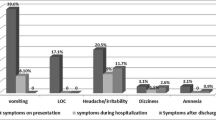Abstract
Purpose
Skull fractures in infants and young children can occur as a result of both accidental trauma and abuse. 1/3 of children with abuse-related head trauma and 1/5 of children with abuse-related fractures were overlooked during the initial evaluation. In this study, we aim to investigate the prevalence of skull fractures that come into contact with the suture in head traumas caused by accidents and abuse, and also to see if contact of the fracture line with the suture could be used as a sign for abuse in the pediatric population.
Methods
Forry-four patients with head trauma were retrospectively assessed between January 2010 and June 2020 and were confirmed to have fractures on a brain CT. Patient age, gender, and head injury type were recorded. The fracture site, location and number, the contact of the fracture line with the suture, the name, and number of the suture it came into contact with were determined.
Results
Twenty-eight skull fractures in 22 children with a diagnosis of child abuse and 25 skull fractures in 22 children due to accidental trauma were evaluated in the same age and gender range. Eighteen (64%) of 28 abuse-related skull fractures were in contact with two or more sutures. Two (8%) of 25 accident-related fractures were related to two or more sutures. Abuse-related fractures had a significantly higher suture contact rate than accident-related fractures (p = 0.007).
Conclusion
Contact with two or more sutures of a skull fracture is a finding related to abuse rather than accident.






Similar content being viewed by others
Availability of data and material
The datasets used and/or analyzed during the current study are available from the corresponding author on reasonable request.
References
Chevignard MP, Lind K (2014) Long-term outcome of abusive head trauma. Pediatr Radiol 44(4):548–558. https://doi.org/10.1007/s00247-014-3169-8
Choudhary AK, Servaes S, Slovis TL, Palusci VJ, Hedlund GL, Narang SK, Moreno JA, Dias MS, Christian CW, Nelson MD Jr, Silvera VM, Palasis S, Raissaki M, Rossi A, Offiah AC (2018) Consensus statement on abusive head trauma in infants and young children. Pediatr Radiol 48(8):1048–1065. https://doi.org/10.1007/s00247-018-4149-1
Sidpra J, Ong J, Birch W, Mankad KJCsns (2021) Skull fractures in abusive head trauma: a single centre experience and review of the literature. 37 (3):919–929
Squier W (2011) The “Shaken Baby” syndrome: pathology and mechanisms. Acta Neuropathol 122(5):519–542. https://doi.org/10.1007/s00401-011-0875-2
Orman G, Kralik SF, Meoded A, Desai N, Risen S, Huisman TAJJoN (2020) MRI findings in pediatric abusive head trauma: a review. 30 (1):15–27
Lonergan GJ, Baker AM, Morey MK, Boos SC (2003) From the archives of the AFIP. Child abuse: radiologic-pathologic correlation. Radiographics : a review publication of the Radiological Society of North America, Inc 23 (4):811–845. doi:https://doi.org/10.1148/rg.234035030
Kriss S, Morris J, Martich VJAJoR (2021) Pediatric skull fractures contacting sutures: relevance in abusive head trauma.1–5
Deye KP, Berger RP, Lindberg DM, trauma EIJJo, surgery ac (2013) Occult abusive injuries in infants with apparently isolated skull fractures. 74 (6):1553–1558
Piteau SJ, Ward MG, Barrowman NJ, Plint ACJP (2012) Clinical and radiographic characteristics associated with abusive and nonabusive head trauma: a systematic review 130(2):315–323
Jenny C, Hymel KP, Ritzen A, Reinert SE, Hay TC (1999) Analysis of missed cases of abusive head trauma. JAMA 281(7):621–626. https://doi.org/10.1001/jama.281.7.621
Reece RM, Sege R (2000) Childhood head injuries: accidental or inflicted? Arch Pediatr Adolesc Med 154(1):11–15
Meservy CJ, Towbin R, McLaurin RL, Myers PA, Ball W (1987) Radiographic characteristics of skull fractures resulting from child abuse. AJR Am J Roentgenol 149(1):173–175. https://doi.org/10.2214/ajr.149.1.173
Hobbs CJ (1984) Skull fracture and the diagnosis of abuse. Arch Dis Child 59(3):246–252. https://doi.org/10.1136/adc.59.3.246
Barber I, Kleinman PKJPr (2014) Imaging of skeletal injuries associated with abusive head trauma. 44 (4):613–620
Kemp AM, Dunstan F, Harrison S, Morris S, Mann M, Rolfe K, Datta S, Thomas DP, Sibert JR, Maguire SJB (2008) Patterns of skeletal fractures in child abuse: systematic review. 337
Christian CW, Abuse CoC, Pediatrics NJ (2015) The evaluation of suspected child physical abuse. 135 (5):e1337-e1354
Hung K-LJbj (2020) Pediatric abusive head trauma. 43 (3):240–250
Paddock M, Sprigg A, Offiah AC (2017) Imaging and reporting considerations for suspected physical abuse (non-accidental injury) in infants and young children. Part 2: axial skeleton and differential diagnoses. Clinical radiology 72 (3):189–201. doi:https://doi.org/10.1016/j.crad.2016.11.015
Author information
Authors and Affiliations
Contributions
All authors contributed to the study conception and design. Material preparation, data collection, and analysis were performed by Berna Uçan and Sonay Aydın. The first draft of the manuscript was written by Oğuzhan Tokur and all authors commented on previous versions of the manuscript. All authors read and approved the final manuscript.
Corresponding author
Ethics declarations
Ethical approval
All procedures performed in studies involving human participants were in accordance with the ethical standards of the institutional and/or national research committee and with the 1964 Helsinki declaration and its later amendments or comparable ethical standards. This study was performed in line with the principles of the Declaration of Helsinki. Approval was granted by the Ethics Committee of Erzincan Binali Yildirim University (11.09.2021-Ebyu/Kaek).
Consent for publication
Written consent to publish this information was obtained from the study participant.
Conflict of interest
The authors declare that they have no conflict of interest.
Additional information
Publisher's Note
Springer Nature remains neutral with regard to jurisdictional claims in published maps and institutional affiliations.
Rights and permissions
About this article
Cite this article
Uçan, B., Tokur, O. & Aydın, S. Pediatric skull fractures: could suture contact be a sign of abuse?. Emerg Radiol 29, 403–408 (2022). https://doi.org/10.1007/s10140-022-02024-6
Received:
Accepted:
Published:
Issue Date:
DOI: https://doi.org/10.1007/s10140-022-02024-6




